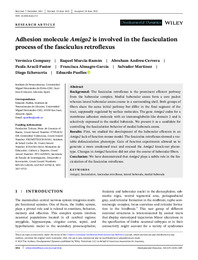Por favor, use este identificador para citar o enlazar este ítem:
https://hdl.handle.net/11000/31171Registro completo de metadatos
| Campo DC | Valor | Lengua/Idioma |
|---|---|---|
| dc.contributor.author | Company Devesa, Verónica | - |
| dc.contributor.author | Murcia Ramón, Raquel | - |
| dc.contributor.author | Andreu Cervera, Abraham | - |
| dc.contributor.author | Aracil Pastor, Paula | - |
| dc.contributor.author | Almagro García, Francisca de Paula | - |
| dc.contributor.author | Martínez Pérez, Salvador | - |
| dc.contributor.author | Echevarría Aza, Diego | - |
| dc.contributor.author | de Puelles Martínez de La Torre, Eduardo | - |
| dc.contributor.other | Departamentos de la UMH::Patología y Cirugía | es_ES |
| dc.contributor.other | Instituto de Neurociencias | es_ES |
| dc.contributor.other | Departamentos de la UMH::Histología y Anatomía | es_ES |
| dc.date.accessioned | 2024-02-06T17:19:31Z | - |
| dc.date.available | 2024-02-06T17:19:31Z | - |
| dc.date.created | 2022-11 | - |
| dc.identifier.citation | Developmental Dynamics 2022 Nov;251(11):1834-1847 | es_ES |
| dc.identifier.issn | 1058-8388 | - |
| dc.identifier.issn | 1097-0177 | - |
| dc.identifier.uri | https://hdl.handle.net/11000/31171 | - |
| dc.description.abstract | Background: The fasciculus retroflexus is the prominent efferent pathway from the habenular complex. Medial habenular axons form a core packet whereas lateral habenular axons course in a surrounding shell. Both groups of fibers share the same initial pathway but differ in the final segment of the tract, supposedly regulated by surface molecules. The gene Amigo2 codes for a membrane adhesion molecule with an immunoglobulin-like domain 2 and is selectively expressed in the medial habenula. We present it as a candidate for controlling the fasciculation behavior of medial habenula axons. Results: First, we studied the development of the habenular efferents in an Amigo2 lack of function mouse model. The fasciculus retroflexus showed a variable defasciculation phenotype. Gain of function experiments allowed us to generate a more condensed tract and rescued the Amigo2 knock-out phenotype. Changes in Amigo2 function did not alter the course of habenular fibers. Conclusion: We have demonstrated that Amigo2 plays a subtle role in the fasciculation of the fasciculus retroflexus | es_ES |
| dc.format | application/pdf | es_ES |
| dc.format.extent | 14 | es_ES |
| dc.language.iso | eng | es_ES |
| dc.publisher | Wiley [Commercial Publisher] | es_ES |
| dc.rights | info:eu-repo/semantics/openAccess | es_ES |
| dc.rights.uri | http://creativecommons.org/licenses/by-nc-nd/4.0/ | * |
| dc.subject | Amigo2 | es_ES |
| dc.subject | fasciculation | es_ES |
| dc.subject | fasciculus retroflexus | es_ES |
| dc.subject | lateral habenula | es_ES |
| dc.subject | medial habenula | es_ES |
| dc.title | Adhesion molecule Amigo2 is involved in the fasciculation process of the fasciculus retroflexus | es_ES |
| dc.type | info:eu-repo/semantics/article | es_ES |
| dc.relation.publisherversion | https://doi.org/10.1002/dvdy.513 | es_ES |

Ver/Abrir:
Adhesion molecule Amigo2 is involved in the fasciculation.pdf
14,89 MB
Adobe PDF
Compartir:
 La licencia se describe como: Atribución-NonComercial-NoDerivada 4.0 Internacional.
La licencia se describe como: Atribución-NonComercial-NoDerivada 4.0 Internacional.
.png)